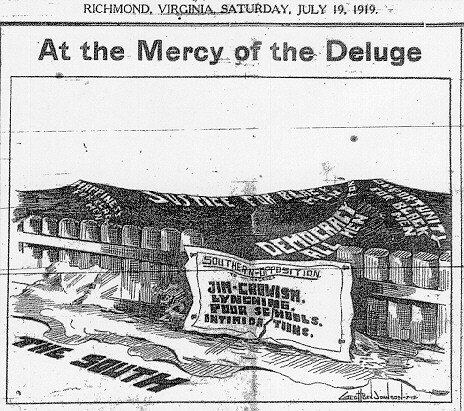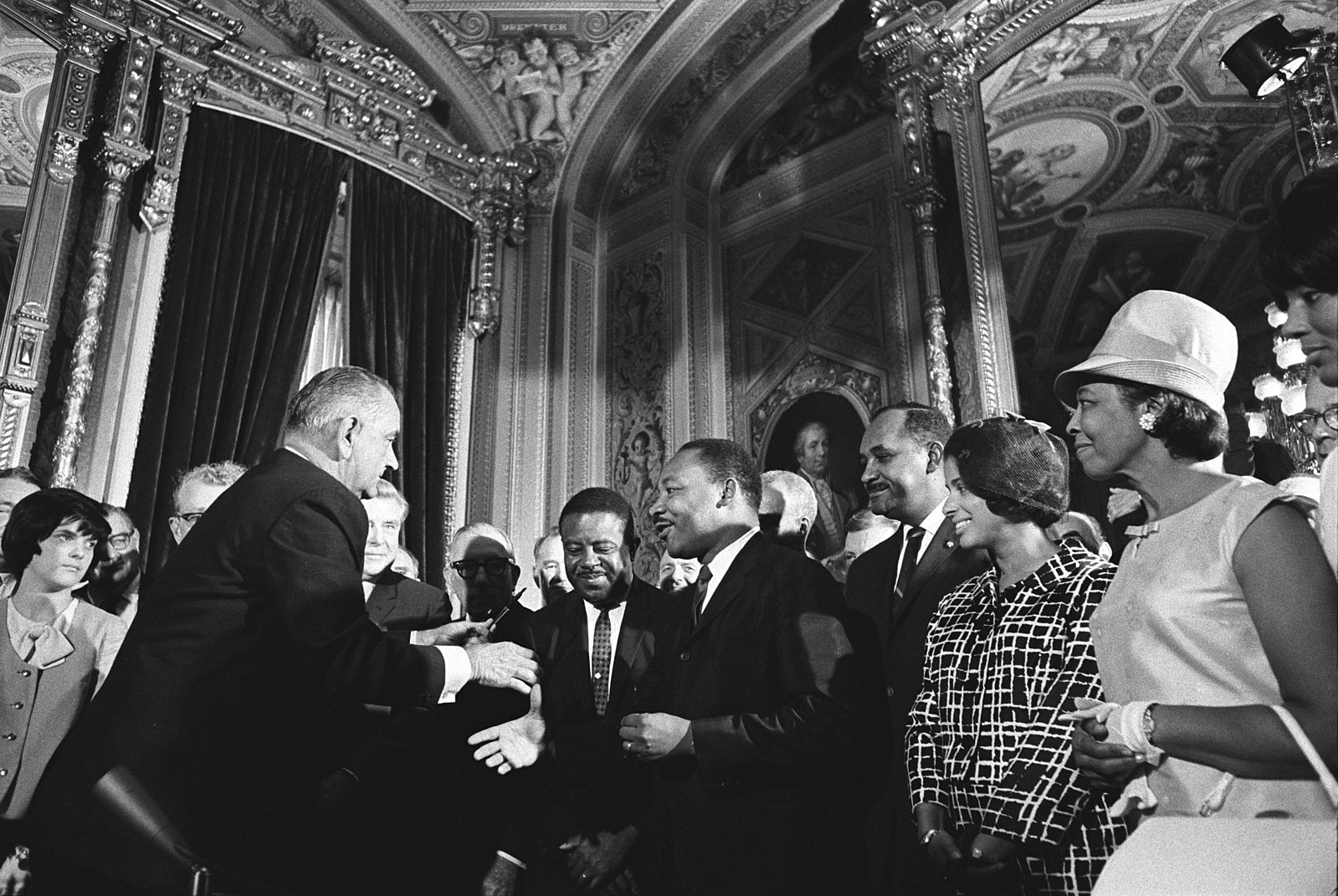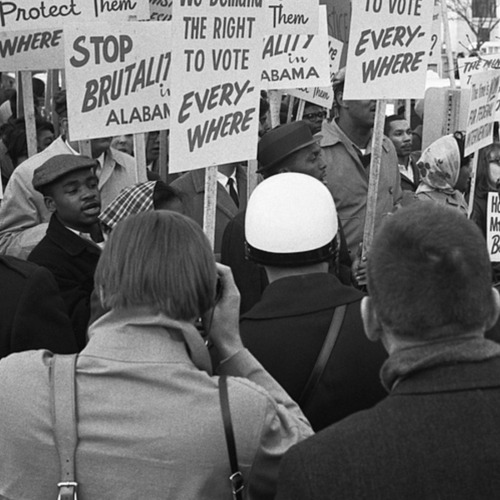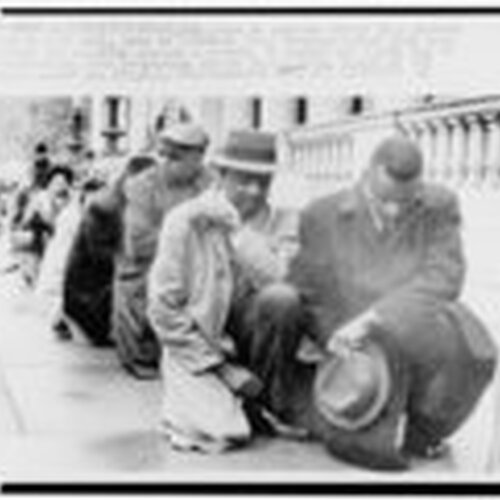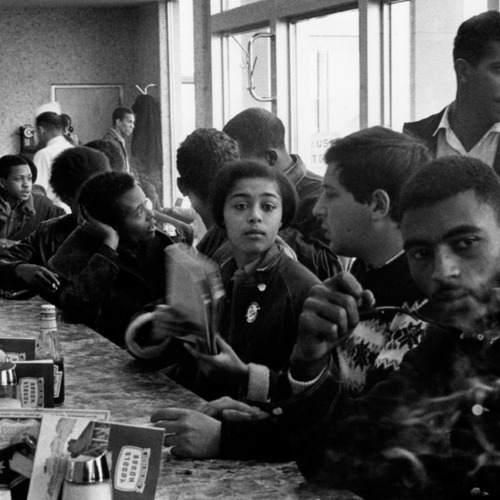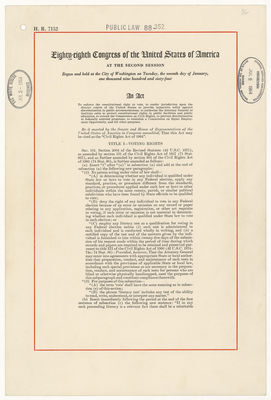Civil Voting Rights (1957-1965)
Overview
This section focuses on the journey of Civil Voting Rights. It dives into the Reconstruction Era and transition towards the peak of the Civil Rights Movement. Specifically, from 1957 to 1965, my project will be focusing on states such as Alabama, Mississippi, and Georgia where the journey of African American Civil and Voting Rights were prevalent. I will be focusing on key historic figures such as Martin Luther King Jr, Rosa Parks, John Louis and Fannie Lou Hamer, and how they used their influence to resist social barriers in terms of civil rights. My goal of the project is to show the efforts and strategies African American used to pursue civil and voting rights, even while facing systematic challenges, and to highlight the importance of democracy.
Print shows African American men, in dress indicative of their professions, in a queue waiting their turn to vote.
Historical Background
Following the end of the Civil War and the Reconstruction era, the 19th century marked the beginning of a systematic retraction of these newly acquired rights. With the emergence of Jim Crow laws and legalized racial segregation, a new era of oppression towards African Americans was created. These laws created barriers to voting in ways such as literacy tests, poll taxes, and the grandfather clause.
The severity of these discriminatory practices varied throughout the South, but the impact was uniformly devastating: voter registration and turnout for African Americans plummeted. In addition to legal barriers, extralegal terror tactics by groups like the Ku Klux Klan further racialized black participation. By the 20th century, African Americans in the South found themselves almost completely excluded from the political voting process.
This ongoing systematic injustice set the stage for the Civil Rights Movement. The struggle for civil rights, including the right to vote, was not just a fight against individual laws but a broader battle against society that deemed African Americans as second-class citizens.
The following images are representative of the "fighting editor's" battle against racial injustice. Of particular note are Mitchell's own editorial cartoons, which satirized the situation of the day.
Key Figures
Martin Luther King Jr. was a key figure in the Civil Rights Movement. His ideology of peaceful protests drew attention to racial injustices. His strategy of nonviolent resistance and speeches played a significant role in advocating for change.
Rosa Parks' refusal to give up her seat on a bus led to the Montgomery Bus Boycott, a crucial year-long protest that demonstrated the power of collective protesting and was a critical point for civil rights.
John Lewiswas known for his participation in sit-ins and freedom rides.
Fannie Lou Hamer brought national attention to the struggles black voters faced in Mississippi. She is most known for her testimony at the 1964 Democratic National Convent which revealed the violent resistance African Americans were facing.
President Lyndon B. Johnson greeting Rev. Dr. Martin Luther King Jr., Rosa Parks, and other civil rights leaders after signing the Voting Rights Act into law, 1965
States
In the heat of the Civil Rights Movement, Alabama, Mississippi, and Georgia became pivotal battlegrounds. These states were known for enforcing policies that hindered African American voting rights. For example, literacy tests were administered subjectively based on race; African Americans were asked nearly impossible questions, White voters were asked easy ones. Another example of this is the enforcement of poll, which required voters to pay a fee - a burden for African Americans that were living in poverty.
In Alabama, the "freedom ballot" in 1963 was designed to show the will of black citizens to vote, in a state where discriminatory practices were rampant. Mississippi's 1964 "Freedom Summer" brought national attention as volunteers from across the country flocked to the state to register African American voters. Georgia, while perhaps not as violently repressive as its neighbors, nevertheless employed practices like "white primaries," which excluded African Americans from the critical initial round of voting.
African American demonstrators outside the White House, with signs "We demand the right to vote, everywhere" and signs protesting police brutality against civil rights demonstrators in Selma, Alabama
African-Americans kneel on sidewalk outside City Hall in Birmingham, Alabama protesting
Adaptation to Resistance
During the Civil Rights Movement, activists faced resistance from local and state authorities, as well as from normal citizens who supported segregation. In order to appropriately respond, activists adapted strategies in many key ways to continue their fight for equality and voting rights.
Efforts were primarily led by community organizations such as the NAACP, and the Southern Christian Leadership Conference (SCLC) which allowed activists more structured approaches to activism and protest.
One of the most significant adaptations was the shift towards nonviolent protest. Leaders like Martin Luther King Jr. promoted tactics such as sit-ins, boycotts, and marches. These methods were designed to draw attention to the injustice of civil voting rights, while making sure they are on a peaceful ground.
Activists also challenged the court to confront unfair laws directly. Thugood Marshall ,alongside with the NAACP, worked to challenge Jim Crow laws. This led to the Supreme Court eventually making decisions that struck down segregation and voter suppression laws.
Finally, activists conducted Freedom Summer in 1964, which aimed to register as many African American voters as possible, specifically in the South. Through these strategies, civil rights activists were able to eventually secure the constitutional right to vote for all citizens.
Civil rights activists occupying a lunchroom counter during a sit-in
Senate. Before final civil rights vote Final day
The Impact of Legislation
The Civil Rights Act of 1957 marked the first legislation since Reconstruction that addressed the rights of African Americans. Its primary aim was to protect voter rights. The Act created a division within the U.S. Justice Department focused on civil rights and introduced mechanisms to monitor federal voting rights. However, its impact was somewhat limited as it didn’t directly tackle the prevalent voter suppression tactics like literacy tests.
However, The Voting Rights Act of 1965 was able to tackle these discriminatory practices. It banned discriminatory practices adopted in many southern states after the Civil War, including literacy tests and other barriers. One of its most powerful features was the requirement for certain jurisdictions with histories of discrimination to receive federal approval, or “preclearance,” before changing their voting laws. This Act significantly increased voter registration and participation among African Americans and is considered a cornerstone of civil rights legislation in the United States.

